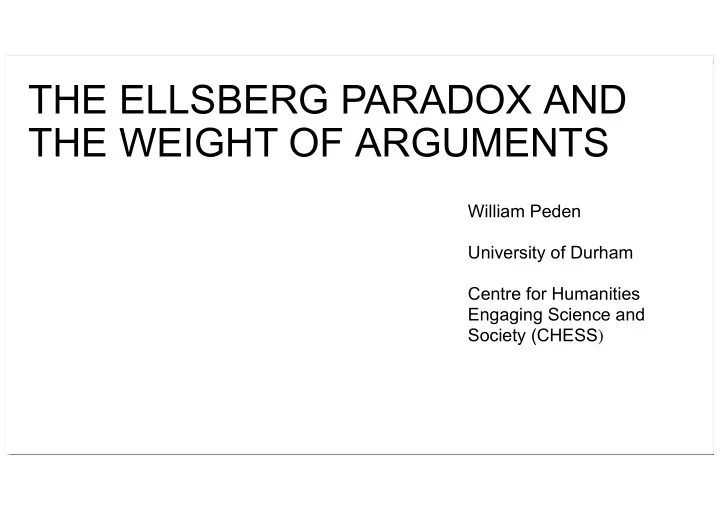

THE ELLSBERG PARADOX AND THE WEIGHT OF ARGUMENTS William Peden University of Durham Centre for Humanities Engaging Science and Society (CHESS )
Standard Approach: Maximize Expected Utility with Imprecise Probabilities: The Evidential Probabilist • Expected utility of an action: the sum of the products of Approach multiplying (1) the probability of each circumstance given William Peden an action by (2) the utility for that action Department of Philosophy • Maximize expected utility: act so that expected utility is as great as possible. Centre for Humanities Engaging Science and • If expected utilities of actions are equal, then you should be Society (CHESS ) indifferent.
THE ELLSBERG PARADOX • Paradox for MEU. • There is a box with- 1/3 black balls Between 0 and 2/3 green balls Between 0 and 2/3 red balls • There are two choices between bets on a randomly selected ball from the box.
A : “The ball will be black.” B : “The ball will be green.” In experiments, most people prefer A to B
C : “The ball will be not be green.” D : “The ball will not be black.” In experiments, most people prefer D to C
THE PARADOX • The EU of betting A is greater William Peden than the EU of B iff the EU of C is greater than the EU of D. Department of Philosophy • Why A > B? Centre for Humanities - Only one possible reason in Engaging Science and MEU theory: more likely that the Society (CHESS ) ball will be red rather than green. • But then why not C > D? • MEU: combination is irrational
PROBLEM William Peden Nothing formally wrong or Department of Philosophy intuitively irrational. Centre for Humanities Engaging Science and Expected utilities CAN be equal. Society (CHESS ) Conservative solution?
EVIDENTIAL PROBABILITY • Developed by Henry E. Kyburg (1928- 2007) • Provides a system whereby all probabilities are derived from information about relative frequencies. • Single probability for given evidence. • Evidential probabilities can be imprecise. - When information is imprecise.
SPECULATION AND DECISION • How do we get a decision-theory with Evidential Probabilities? • Speculate relative frequency information that is consistent with the Evidential Probabilities. • Bet as if we knew the relative frequencies.
EXAMPLE • Tossing Gömböc: very imprecise prob. - Maybe [0, 1] • Tossing a 1 euro coin: relatively precise prob. - Like [0.49, 0.51] • Many would speculate: 0.5 (1/2)
SPECULATION AND DECISION There is a pre-theoretical distinction between- (1) Making decisions based on evidence. (2) Making decisions based on speculation. A difference of degrees – measure with Evidential Probabilities. A tie-breaker if expected utilities are equal.
IMPRECISION AS A DECISION TOOL • Bet with even odds. • Gömböc or coin? • Coin, because less speculation.
THE ELLSBERG PARADOX: The Evidential Probabilist Approach • You know that 1/3 balls are black and that [0, 2/3] are green. William Peden Department of Philosophy • You might speculate that 1/3 are green. Centre for Humanities • EU for each choice is equal. Engaging Science and Society (CHESS ) • A is less speculative than B. • D is less speculative than C.
WEIGHT OF ARGUMENTS • John Maynard Keynes: quantity of relevant evidence (in an argument for some action) matters. • But how? • It can help us choose when expected utilities are equal.
CONCLUSIONS A conservative response to the Ellsberg Paradox? - Yes. Is Evidential Probability AND precise decision theory? - Yes. Does the Weight of Argument matter? Sometimes.
Recommend
More recommend